Looper pedals are in a league of their own. They’re one of those gears that aren’t exclusively tied to tone shaping but pure artistry. This means that choosing the best looper pedal will largely depend on your style and how you use loops.
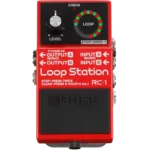
Boss RC-1
The Boss RC-1 is a reliable looper pedal that gets the job done with its simplicity and practical features.
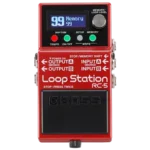
Boss RC-5
The Boss RC-5 takes basic looping a notch higher with extra features, more control, and better display.
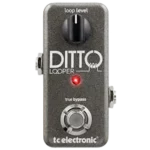
TC Electronic Ditto Looper
The Ditto Looper from TC Electronic is the ultimate minimalist looper. Compact, reliable, and super easy to use.
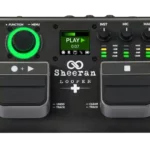
Sheeran Looper
Developed in collaboration with Headrush, the Sheeran Looper + is a feature-rich looper with a user-friendly interface.
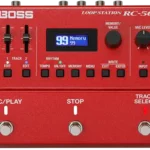
Boss RC-500 Loop Station
The Boss RC-500 is a powerful looping solution from Boss, with a guitarist friendly interface and feature set.
We’re reader-supported. When you click product links on our site, we may earn an affiliate commission at no extra cost to you.
Artists like Ed Sheeran or Kimbra have used looper pedals to layer up their sound on the spot. Each added layer progresses a singer/songwriter setup into a one-man band.
With so many different brands and options, choosing the best looper pedal can be daunting. After all, each genre and person has a unique looping style. Here, we’ll help make this selection easy for you, specifically catering to the needs of guitarists.
In this 2024 edition, newer and more powerful loop pedals have superseded our previous recommendations. Here, we feature the current best looper pedal options in the market.
Many of the very best looper pedals are still from big-name brands like Boss and TC-Electronic. But some wildcards from Boomerang and the new Sheeran Guitars line deserve closer inspection.
Boss RC-1
Best Simple Looper
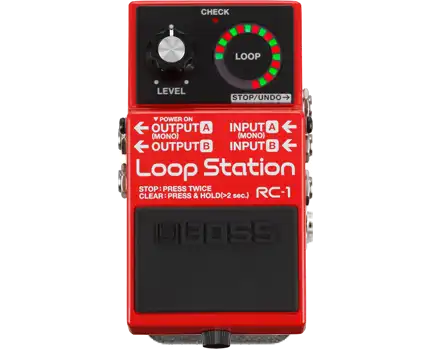
Boss RC-1
Guitarsite Expert Opinion
The Boss RC-1 is a straightforward looper pedal appreciated for its simplicity and practical features, including a volume knob and LED display for easy control.
Manufacturer: Boss
We’re reader-supported. When you click product links on our site, we may earn an affiliate commission at no extra cost to you.
This looper makes live looping much easier because of the LED step sequencer. It gives you all you need to time your loops correctly.
Boss products have dominated the market due to their reliability and good build quality.
The RC-1 is the most basic of all Boss’ Looper lineups. It doesn’t have flashy onboard effects. Instead, where it shines is ease of use and simplicity. It has enough looping capacity to layer up to 12 minutes worth of stereo loops.
At the front of the pedal, you have a big volume knob for easy level control over your loops. You also have an LED display with 24 steps to provide a visual cue. It allows you to see where you are in the loop.
What mode is selected in the pedal switch is also conveniently reflected in the LED display from recording your first loop to your overdubs. You could also connect an external foot switch to the RC-1 as well.
This looper pedal is also capable of both mono and stereo inputs and stereo outputs. You can connect 2 mono instruments for looping in multi-instrumentalist setups.
There’s always a pedal for musicians who prefer to go basic or zen with their rigs. However, it could also aid you in collaborative setups. Undeniably, the Boss RC-1 is a great starter pedal for beginners and professionals alike.
Pros:
- 24 Step LCD Display that works well
- 12 minute recording time, enough for basic looping use
- Resilient, Boss-grade build quality
Cons:
- No power supply included
- Lacks onboard effects
Specifications: | |
|---|---|
Total Loop Time: 12 Minutes | Loop Memory Slot: Internal |
Audio Quality: Not Specified | Input: 2 x 1/4″ (Stereo) |
Output: 2 x 1/4″ (Stereo) | Power: DC Adapter (Optional) or 9V Battery |
Extra Feature: 24 Segment Loop Indicator, Stereo In/Out | Dimensions: 2.375″ x 5.125″ x 2.875″ |
Weight: 1 lb. | |
Boss RC-5
Best Compact Looper
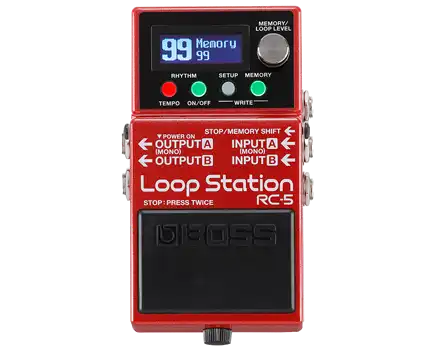
Boss RC-5
Guitarsite Expert Opinion:
The Boss RC-5 offers streamlined looping with robust features, ideal for solo performers and songwriters. Its tank-like build ensures durability, while 13 hours of stereo recording capacity gives you the assurance that you have more than enough to generate musical ideas.
Manufacturer: Boss
We’re reader-supported. When you click product links on our site, we may earn an affiliate commission at no extra cost to you.
The best looper pedals out there have a streamlined looping process and a blend of simplicity and extra features.
For a small form factor, the Boss RC-5 takes the design of a simple looper, turning your performances into a solo orchestra. This loop pedal enables you to do your loops and overdubs in pristine, 32-bit audio.
At the back of our minds, we do have the fear of running out of loop overdubs. With this looper, you’ll also not run out of loop capacity, enabling you to record a whopping 13 hours of stereo recording. That’s more than enough time for you to get creative.
Throw in an external footswitch or an expression pedal, and you have a whole powerhouse of functions for its built-in parameters.
Thanks to the boss stereo looper engine, the RC-5 provides 7 different drum kits and 57 preset rhythms. You can save your presets in the box using one of its 99 memory patches.
You could also add your custom-made beats as well. Hook it to a USB port and drag the file over RC-5’s storage.
The LCD gives you a visual representation of where you are in the beat. The top gives you a four-bar count and a continuous time duration at the bottom.
My only minor issue is it only has reverb as an effect. It would also be great if there’s a built-in basic compressor to tame the transients of the drum loops.
Overall, both beginners and seasoned professionals will benefit from Boss RC-5. To be specific, however, its features are a great fit for singers/songwriters who make custom beats on the side.
Pros:
- Tank-like signature boss enclosure
- 13-Hour Loop Storage. Good for storing riffs and ideas
- USB-ready, extendable memory of up to 99 phrase presets
- Can double as a percussion auto-accompaniment tool with 114 Drum patterns
Cons:
- Features feel a bit cramped using a single footswitch control
- Lacks a simple compressor for taming beats
Specifications: | |
|---|---|
Total Loop Time: 13 Minutes Stereo | Loop Tracks: 1 |
Loop Memory Slot: Internal with USB Support | Audio Quality: 32-bit/44.1kHz |
Input: 2 x 1/4″ (A/mono,B) | Output: 2 x 1/4″ (A/mono,B) |
Power: 9V Battery, 9V DC power Supply (Sold Separately) | Extra Feature: LCD Display, Built-in Drum Patterns, Stereo In/Out |
Dimensions: 2.375″ x 5.125″ x 2.875″ | Weight: 1 lb. |
USB-Ready: Yes | |
TC Electronic Ditto Looper
Best for Beginners
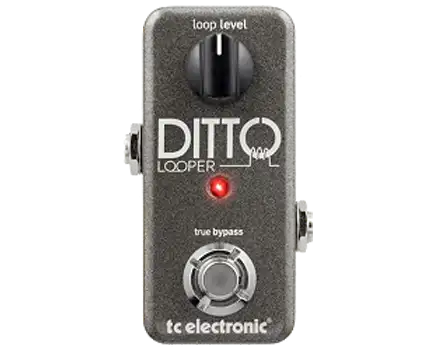
TC Electronic Ditto Looper
Guitarsite Expert Opinion:
This straightforward looper pedal prioritizes top-notch audio quality and recording capacity over complex features. With simple controls for recording, overdubbing, and playback, it offers up to 5 minutes of recording time, ideal for songwriting and practice sessions. While lacking advanced features, its true bypass circuitry ensures transparent sound.
Manufacturer: TC Electronic
We’re reader-supported. When you click product links on our site, we may earn an affiliate commission at no extra cost to you.
Instead of battling the many complex loopers on the market, the TC Electronic Ditto Looper sticks with the simple route. Sporting a compact looper pedal design with just one switch that’s smaller than regular guitar pedals. Its simple one-footswitch design allows for basic looping functions in a compact stompbox form factor.
This is credited for starting the compact looper craze; other manufacturers eventually joined. Govan, Gilbert, and other guitarists have used this pedal well, boosting its popularity.
Instead of complicating matters with more controls and features, this simple looper pedal focuses on providing the best possible audio quality and recording capacity.
It won’t let you tweak deep settings, but for a single footswitch pedal, it enables you to trigger recording, overdubs, play, and stop, and it even allows for undo and redo via different ways of stepping on the switch.
As for memory, this small footprint stompbox gives you up to 5 minutes of recording, more than enough for a complete song with multiple loops, be it for practice or performance.
True bypass circuitry and analog-dry-through circuitry ensure good transparency, making this an ideal discrete addition to any pedalboard or rig.
But given its size and price, it’s just a looper pedal; don’t expect extra features. A more advanced version called the Ditto+ is also available, and it features TC-Electronic’s groundbreaking extended Loop Mode that lets you do longer and more complex recordings and overdubs.
My only concern for this pedal is that it requires more time to get used to the single footswitch interface, but it is still one of the best looper pedal deals if you are looking for a compact looper.
Pros:
- Unparalleled simplicity
- Transparent-sounding audio quality
- Construction and look are solid
Cons:
- No tempo sync
- Mono looping only
Specifications: | |
|---|---|
Total Loop Time: 300 Seconds | Loop Tracks: 1 |
Loop Memory Slot: 1 | Audio Quality: 24-bit A/D/A |
Input: 1 x 1/4″ | Output: 1 x 1/4″ |
Power: DC Adapter | Dimensions: 1.9″ x 1.9″ x 3.7” |
Weight: Less than 1 lb. | |
Sheeran Looper +
Best Dual-Track Looper
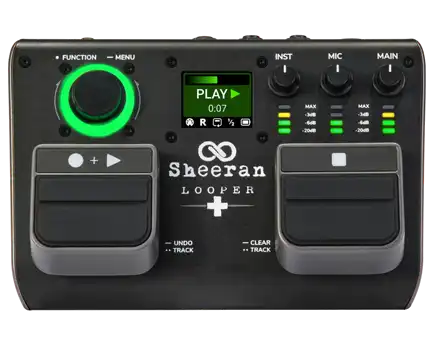
Sheeran Looper +
Guitarsite Expert Opinion:
The Sheeran Looper + was developed in collaboration with Headrush. It offers a relatively compact yet feature-packed design, boasting stadium-grade construction and a user-friendly interface.
Manufacturer: Sheeran Guitars
We’re reader-supported. When you click product links on our site, we may earn an affiliate commission at no extra cost to you.
Just to give you context, the Sheeran Looper + has created quite a buzz. For years, Ed Sheeran has used a custom-made looper pedal named Chewy Monsta. It was so sought-after that people tried deconstructing how you could DIY one via instructions.
In collaboration with Headrush, Ed Sheeran has released two Looper pedals. One is the Sheeran Looper + and the second is the Sheeran Looper X. Looper + is the cheapest of the two.
They call it a “stadium-grade looper” for a reason. It uses a die-cast aluminum chassis and a full-colored LCD in the middle of the unit.
At the front panel, you could see they’ve done a stellar job condensing everything you need.
The function/menu knob will give you access to its main features. The INST, MIC, and MAIN dials are responsible for the levels and the signal is indicated by the LED.
Bringing focus to the function menu knob, several features struck me. It is similar to the Electro Harmonix 720 stereo looper where you could half time your recordings. Here, though, the 32-bit capabilities of Looper + will preserve the sound quality and dynamics much better.
Each of us has our unique ways of looping our instruments. The Sheeran Looper + gives you 4 loop modes for single—and dual-track recording. These 4 loop modes have made the 4 common loop workflows accessible to you.
It is not just a dial. It’s also a quick access button to assign how your loops should play. Want to end your performance smoothly? Assign it to FADE OUT, then press it when it’s time to wrap it up. Want to create soundscapes? You could reverse the loop and layer it up with other instruments.
You could store over 128 loops and store your custom-made beats. Like most advanced looper pedals, it is USB-ready, you could double it up as an audio interface as well.
I could easily imagine a scenario where I could loop back any sound from my computer. Then, feed it back to the unit for a more unique sound.
For the downside, I’d say would be to add dedicated volume controls for dual-channel setups. It is especially useful for multiple instrument setups. This way, the artist can balance their own backing tracks on the spot.
Another would be the inclusion of a headphone output for on-the-go or bedroom rehearsals. If it doubles as an interface, this makes perfect sense.
It’s not only a looper. It can double as an audio interface. This makes it great for storing ideas and having streamlined access to your files.
If you’re an intermediate singer/songwriter or a guitarist, the Sheeran Looper + offers you a slew of features packed in a small form factor. It’s one of the contenders for the best looper pedals among the more recently released models.
Pros:
- Packed with features for both guitar and vocals
- Can function as an audio interface as well
- Storage for custom beats via USB
Cons:
- No independent volume control for A and B Loops
- No headphone slot
Specifications: | |
|---|---|
Total Loop Time: 1.5 hours | Max Layers per Loop: Unlimited |
Max Overdub Time per Loop: 30 minutes | Loop Tracks: 2 |
Loop Memory Slot: ~4.1 GB | Audio Quality: 24-bit/44.1 kHz |
Input: 2 | Output: 2 |
Power: Via 4 AA Batteries (included)
USB bus power
9 V, 500 mA (center-negative) power adapter (not included) | Extra Feature: TFT LCD Display, Built-in Drum Patterns, Stereo In/Out |
Dimensions: 8.52” x 6.24” x 3.00” | |
Best Gigging Looper
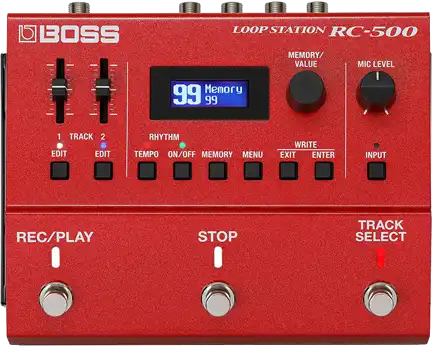
Boss RC-500 Loop Station
Guitarsite Expert Opinion:
The Boss RC-500 Loop Station offers professional-grade looping in a compact three-footswitch design. Ideal for one-man-band setups. It has robust looping capabilities, including 2 individual tracks and pristine overdubs. Despite its smaller size, it packs a punch with ample memory and versatile effects.
Manufacturer: Boss
We’re reader-supported. When you click product links on our site, we may earn an affiliate commission at no extra cost to you.
If you are looking for something lighter and smaller than the RC-600, its portable sibling, the Boss RC-500, may very well be the one you need.
It features the same sonic quality as the new flagship model, only this one is packed in a smaller three-footswitch form.
Some features are stripped down as expected, but it still has enough for one-man-band musicians and singer-songwriters to make great music.
Ed Sheeran used to be one of the many professional artists who performed using compact Boss loop stations, like the older RC-30 model. And there are many others, including popular YouTube live-looping artists.
The RC-500 has 99 phrase memories, with a total memory capacity of up to 13 hours. This generous looping time allows for multiple albums’ worth of pre-loaded loops, making it perfect for live looping performances that require long build-ups.
Each loop has dedicated parameters to tweak, including loop volume, effects application, and more.
In addition to its substantial memory, the RC-500 is equipped with a wide array of presets. It boasts 57 percussion patterns, 16 drum kits, and drum machine samples for instantly adding rhythmic elements and percussive textures to your practice and performances.
Coming from Boss, it comes with a comprehensive effects section that includes 16 effects with ample parameter controls.
These effects can be applied to individual loops or the overall mix, offering a diverse palette of sonic possibilities.
Controls are limited, but it is enough for what this looper processor is meant for. With a bit of practice, the controls will quickly become second nature. If you’re looking for an intuitive looper with more features than smaller units, get this.
Pros:
- Robust looper with 2 individual tracks
- Pristine looping maintained in overdubs
- Great looping process for one-man band setups
Cons:
- No power supply included
- Some effects are impractical to use
Specifications: | |
|---|---|
Total Loop Time: 13 hours | Loop Tracks: 2 |
Loop Memory Slot: 99 | Audio Quality: 32-bit/44.1 kHz |
Connectors: INST IN A/MONO, B jacks: 1/4-inch phone type
MIC IN jack: XLR type (balanced, phantom power: DC 48 V, 10 mA Max
OUTPUT A/MONO, B jacks: 1/4-inch phone type
CTL 1,2/EXP jack: 1/4-inch TRS phone type
MIDI (IN, OUT) jacks: stereo miniature type
DC IN jack | USB: USB micro B type |
Power: Alkaline battery (AA, LR6) x 4
AC adaptor (PSA-S series: sold separately) | Dimensions: 5.43” x 6.69” x 2.44” (approx.) |
Best 4-Track Looper
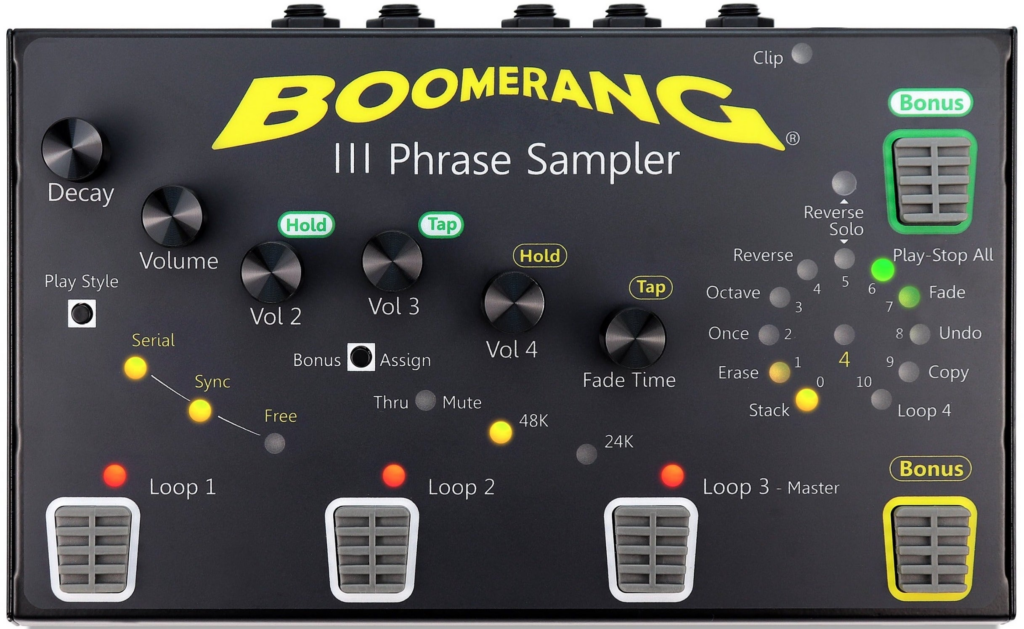
Boomerang III Looper Pedal
Guitarsite Expert Opinion:
Right off the bat, the 80s retro sci-fi look of this looper pedal exudes that it’s had its share of interesting experiences in bars and venues.
And rightfully so. The Boomerang III Looper Pedal has been included in our list for its interesting layout and a plethora of features. It is truly an all-in-one pedal for loopers.
Manufacturer:
Boomerang Musical Products
We’re reader-supported. When you click product links on our site, we may earn an affiliate commission at no extra cost to you.
The front panel includes 3 pedals as your main footswitch for looping parts and 2 “bonus” pedals for onboard effects and basic functions.
However, what’s surprising is that, for multiple loops, you can include a 4th loop to your signal chain. This gives you even more control over the individual tracks.
Each of the pedals is coupled with volume knobs that can be tweaked on the fly.
You could utilize these 4 pedals in really elaborate multiple-instrument setups. For instance, loops for keyboards, guitars, and drums can be allocated on two different channels. Simultaneously, you can introduce drums and vocals on the 3rd and 4th channels.
Two of the bonus foot switches enable you to add some effects to your performances like reverse, fade-outs, and octaves. They are also easily triggered by either holding or tapping on the pedal.
For the fade out, you could control how long or short it happens by dialing the “fade time” to your liking.
The play style functionality has 3 modes: serial, sync, and free. When you start looping at either loop 1 or 2 “serial” mode gets activated. This means that only one of the loops is going to play and not both at the same time.
Tapping the loop 3-master first will not switch to loops 1 and 2. Instead, it allows you to sync with either loops 1 and 2. These play-style modes give you the freedom to switch between verse and chorus sections. They’ve also included the free mode that allows you to play freely without tempo syncing.
Now for some features, I wish were included. I think lots of guitarists would benefit if there’s a universal LCD to have a quick glimpse of where each parameters are assigned to. It’s also good to have a simultaneous mode for both tracks 1 and 2 for added flexibility.
The Boomerang III Looper Pedal is a great rig for those who are seeking to expand their looping capabilities. This looper pedal is for intermediate to seasoned musicians who have tons of experience in elaborate setups.
Alternatives to the Boomerang II include the Pigtronix Infinity Looper and the more feature packed Boss RC-600.
Pros:
- Expandable up to 4 loops
- Fully assignable effects for loop execution
- Switchable play styles. Great for verse/chorus sections
Cons:
- Footswitch workflow can be a bit inconvenient
- No external storage for loops and riff ideas
Specifications: | |
|---|---|
Total Loop Time: Up to 35 minutes (2100 Seconds) | Loop Tracks: 4 |
Loop Memory Slot: Up to 4 | Audio Quality: Output (24-bit / 48kHz) |
Input: 2 x 1/4″ (L/R), 1 x Rang Pedal Link | Output: 2 x 1/4″ (L/R), 1 x Rang Pedal Link |
USB: None
| ower: 9V DC Power Supply |
Dimensions: 9” x 2” x 6” | Weight: 3.59 lbs. |
Things to consider when buying the Best Looper Pedal
Loop Tracks or Channels
The number of loop tracks and loop channels is a key looping function that you should consider.
Most smaller looper pedals have single-channel functionality, which gives you just one track to play around with.
This is usually enough for those who want to loop simple phrases played on an electric guitar. These are ideal for guitarists already playing with a band and have little room left in their pedalboard.
While you can overdub everything on a single loop track, having multiple tracks allows for more efficient control and enables you to record rhythm, lead, and other parts separately and have individual control over each track.
This is imperative for one-man-band live performances where you do multiple parts and build your music via different tracks.
Loop Time
Loop time dictates the amount of time you can record, which is dictated by the amount of memory available. Generally speaking, the longer the loop time available, the better, unless you are the type that gets distracted into fiddling instead of being productive.
Some pedals have enough loop time to record parts for entire albums, but some have considerably lower memory. This is a specification to watch out for.
Input/Output Options
Guitarists will usually need one or two (for stereo rigs) inputs. These pedals are easy to set up and offer basic looping functionality, ideal for practice and playing with musical ideas.
But if you plan on multiple instruments and vocals, you’ll want one with more input options. If you plan on using the pedal for live performance, you must check if the output options match your current gear and setup.
Control Options
Essential controls include record, play, overdub, and stop – all of which should be accessible via footswitches for hands-free control. Other controls that are nifty include undo, redo, and bypass. Single pedal size units will have fewer switches and buttons, which makes them easy to set up and use.
Multi-track loopers allow for more loops and in-depth control, including auto-quantizing, tap tempo, syncing, time adjustments, etc. Most popular looper pedals even offer built-in effects that let them emulate a reverb or delay pedal. These may sound extreme or impractical, but you’ll change your mind when you try complex one-man-band arrangements.
The extent of control options you need depends on the complexity of your performance. You can add external footswitches if you need more handsfree options.
Reliability and Form Factor
You want a looper pedal that can handle regular use, especially the footswitches, which will get excitedly stepped on many times, unlike other set-and-forget pedals.
This is where reputation and recommendations come in, and big brands like Boss take the limelight.
The size and shape of the pedal are usually secondary, but if pedalboard space is scarce, you’ll want the smallest you can find. Most loop pedals come in the standard pedal shape, but there are variations as you go smaller or bigger.
If you’re looking for multi-track functionality, you must make room for bigger multi-effect type units.
If you’re looking for loopers and effects designed to work primarily with vocals, check out Gearank’s Vocal Effects Pedal / Processor Guide.
Alexander Briones
Lead Author
Allen Articulo
Contributor: Research and Supplemental Writing


27 thoughts on “Best Looper Pedal Selection 2024”
TC Electronic Ditto Looper – It’s a great pedal. Suitable for different styles of music
I think the main thing in Looper pedals are to have zero latency, two or three tracks, no drums, a way to record or pre-record for a live performance and a way to select the pre recordings bass on the song you want to play without necessarily having to play them in a certain sequence.
by the way. is there a pedal besides Looper that can be “trained” to play lower octave bass lines that follow your guitar chords. would be handy live for songs where the bass line follows the chord melody.
rr
I have a TC Helicon voice Live Extreme and has looping. I read Ehx has new grand canyone and 9000 model dedicated looper. What is easiest to use for control, mixing etc. ?
I have a tc ditto x2 for my guitar, but now want one for my drumming to make a verse and chorus loop of a few measures instead of playing full songs on my drums. I am looking for a looper with a count in feature. I see some of the boss ones have it, but I don’t like the switch loop feature on those from what I see. I had the ehx 22500 and that had a loopA and loopB but I don’t think that had a count in feature. any products you can suggest? I don’t want that massive boss looper, too big and expensive for my needs.
Hi,
Does anyone happen to know the DIFFERENCE/UPDATE/IMPROVEMENT, between the:
1) Donner Looper 10 Minutes Looping Time Guitar Effect Pedal Best Quality
and…the…
2) Donner Updated Tiny Looper Effects Pedals Unlimited Overdubs 10 Minutes of Looping ?
I appreciate your attention to this inquiry and I look forward to your response.
Sincerely,
M.H. De Z.
Hi,
Would you please be so kind, so as to give me your professional and honest opinion on which of these two “Looper Pedals” you consider to be the better choice.
1) TC Electronic Ditto (5 minutes) Looper Guitar Effect Pedal?
OR…
2) Donner Looper (10 minutes) Guitar Effect Pedal?
I very much appreciate your kind attention to this inquiry and look forward to your response.
Have a nice evening and a great new week.
Sincerely
M.H. De Z
How would you record 1 measure of click/bang rhythm and the 4 measures of chord changes without the 1st measure of chords being repeated before you get to the last three? Must you record 4 measures of click/bang rhythm to prep for 4 measures of chords?
How would you record 1 measure of click/bang rhythm, then 4 measures of chord changes without the first measure of chords repeating before you get to record the last three measures of chords, Must you record 4 measures of click/bang rhythm?
So I want to loop. I have looped basic rhythm for practicing lead over chord progressions, so I am a complete newbie.
The song I want has a verse before a chorus (repeating forever) with different percussion and chord patterns for each.
For live it seems I want to:
1. Record the percussion of the chorus: boom chuck, boom chuck. Record only one measure for the chorus which is 4 measure long (the chord progression to be recorded live when I get there the first time in the song).
2. Record the percussion of the verse: click bang, click bang for one measure of 4 in each verse.
3.Record the chords while singing live the first verse.
4. Switch to playing the chorus percussion and record the chord progression live while singing the chorus. No recording of vocals (yet).
5. Switch back to playing the verse percussion and chords for playing lead over the verse.
6. Switch back to playing percussion and chords of chors and sing/record live the chorus to be ready for overlay live harmony of chorus.
What machine would be do this?
The demos I see show the recording of a 4 measure backing track with only an equal number (4) of measures in overlays. When that song’s chord progression changes that looper must stop playing everything (unless the percussion remains the same. In which case one can loop down??? to the loop immediately below the most recent loop. In this case the demo over-layed 3 loops of equal length, then backed away from the third to hear only the first two playing.
Does my scenario require multiple tracks? Do I need a separate track for each portion of the song when all components are different? i.e. a third track if I need different percussion and chords for a bridge?
Can I get back to the verse track and loop down to turn off (temporarily the chord progression) and play live something else, then later add the old chord progression back in?
Do these questions make sense?
From your description, it appears that you need a looper with at least 3 tracks, and for that the Boss RC-300 would be your best bet. It has the flexibility to let you choose loop length and allows for independent record/undo for each of the three tracks.
the questionsi have is this.. i have umpteen pedals and loops
i play through a Marshall guitar amp
i want to add a bass so i can play live
im trying an eden amp. when i plug in a bass the bottom end on the Eden is to die for, but when i use in above config.. the bottom isnt there..
is there a crossover i should use etc.. tks
Hi, I am looking for the perfect loop pedal that can record more than one loop has fx and can save as well as a long battery and recording time. It would also be great if it didn’t cost to much. Thanks for your time and I look forward to your reply!!
The Boss RC-30 is a good 2-track looper that meets most of the features you listed above. I personally have the RC-300, which is a bit bulkier and more expensive, but provides me with the flexibility that I need. If budget is limited, the Li’l Looper is a good alternative, but note that it will have limitations.
Hi
I’m using the closest to Ed Sheeran’s Chewie Minsta looper.
It was made for me ay http://www.sonnit.co.uk and you can also see it working for your self if you type in chewie monsta on you tube is is run by a software program called Mobius free at circular labs.
It has 4 separate tracks.
Too much to explain here check it oyt for yourself it is truly amazing.
Cheers
Alan
Hello. I’m looking for a basic Looper. I thought memory would be a big deal, the ability to save off some of the riffs you’ve created. The reviews and reviewers seem to think other things are more important.
Thanks,
Ken
What’s reverse for? Backward recording?
When enabled, this feature reverses the playback of the loop, resulting in interesting sounds and textures.
I think the problem with most looper pedals is that they only have one track. A few, very few have two tracks. For me I’d want a minimum of two tracks – one to build up percussion/rhythm and a second for music. This seems to be the holy grail. If you just want to endlessly build one single loop, with no way of stripping it down then there are hundreds of pedals. My mind hurts from looking at pedal after pedal after pedal and even just to find out how many tracks it has is a nightmare. Might as well just look at how many stomp switches it has. Basically as far as I can see, the only option for multiple loops (apart from the Big Boss stuff or the pig thing) is the Rang III. Only problem is, it’s expensive and difficult to buy, or even more expensive if you don’t live in the USA. Either way, I’m holding on to get the cash to buy a Rang III. The company that comes out with a pedal with 4 stomps (3 separate tracks and a 4th stomp fro control), a mic input AND a guitar input with NO effects, No reverse NO crap add ons, JUST looping, at a reasonable price will clean up. I want to loop with tracks and I’m not concerned about FX. The Rang III is the closest to that but will need a small mixer to get a mic and gtr in at the same time.
Boss RC-50 is closest to what you want (3 loops). Has reverse but no fx. I had one but it died so I traded it up (direct to Boss) for a discounted RC-300 on which I seldom use the FX save pitch shift. Peace
TC Helicon VL3X (VoiceLive3 Extreme)
Great for voice
Great for guitar pedal (Effects/looping etc.)
Great for looping
Great for keyboards
Great for drum tracks
Amp simulation
Bass simulation
Can loop in and out through songs and sound like a 4 or 5 piece bank with only 1 person performing live…
The VoiceLive 3 is a fantastic piece of gear and it’s currently one of the top recommended voice/guitar effects units on Gearank.com – https://www.gearank.com/guides/vocal-effects-pedal#VoiceLive3
I’ve grown exhausted looking for looper pedals that sound good, are easy to use, and quantize. Basically, I’m looking for a pedal that can sync seamlessly from loop to loop and have several minutes of recording time. Please help!
It sounds like you want the EHX 22500 because it has quantizing and has 12 hours of recording time.
Why are these guys just doing mindlessly repetitive circular go nowhere stuff. Dont these things have ability to produce song length loops?
A song length loop would be pointless because once you get to the end of the song there is nothing to repeat (except to play the song all over again).
Perhaps you meant something else?
In any case, we’ve just updated this roundup today and we’ve added more videos which show the power of what you can do with a looper.
If you still feel there’s something missing, please be more specific, and I’ll try to help you out.
I take back what I said back in 2015 – I was only thinking of loops you create on the fly while performing.
Song length loops can be useful if you can store them to memory because that means you can use them as a ‘backing track’ to play over and add to both when performing, and when sketching out new song ideas without having to set up recording software or a multitrack recorder. I didn’t think of that at the time because I’d only ever used short loops myself.
Nice roundup! Personally, I chose the Boss RC-3 when I was in the market for a looper but I’ve also used my friend’s Ditto looper and it’s AWESOME at what it does. My looper has drastically improved my skills – I highly recommend them.
Whether it’s the Ditto, Boss, or DigiTech…they’re all solid loopers it’s all about what you need and what you do with them. Cheers!